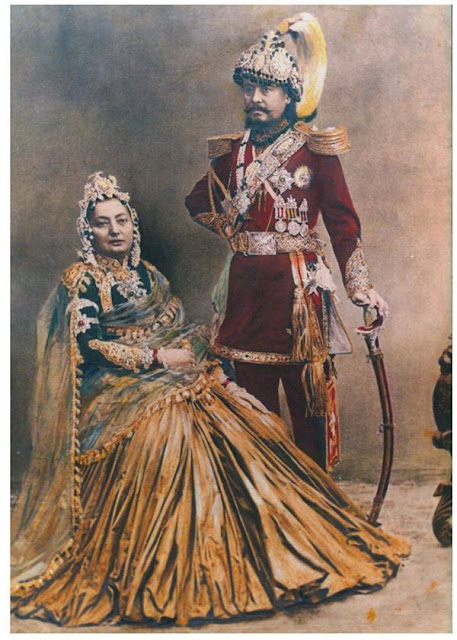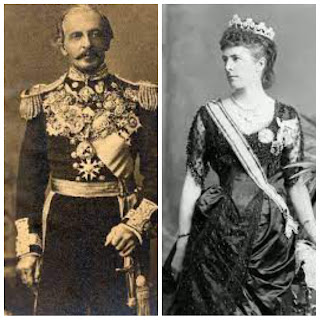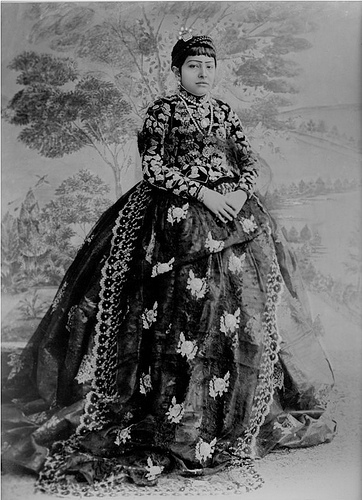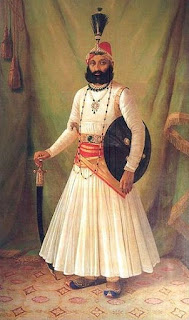Two half-sisters were married to the Wali’Ahad – a Persian formulation for ‘heir to the throne’ – Crown Prince Trailokya Bikram Shah of Nepal. These marriages took place in short intervals, the elder sister Tara Rajya Luxmi Devi got married to Trailokya in 1857 A.D. when she was just seven years old and he just nine. A few years later her half-sister Lalit Rajya Luxmi Devi got married to the same prince in 1860 A.D. when she was but six years old. Both of them were daughters of Maharajah Jung Bahadur Rana, prime minister and de facto ruler of Nepal.

Photo by Clarence Comyn Taylor, 1863 A.D.

Jung Bahadur Rana, a talented army officer, was emerging in the ranks when he married his second wife Nanda Kumari Devi of a Tandon Khatry family from Gorakhpur. His first wedded wife Prasad Luxmi Basnet had passed away giving him his first born son Bhim Jung. After he got married a second time, his fortunes changed. The Court intrigues among the royal family and the courtiers had culminated in the epochal Kot Massacre of 1846 A.D. thrusting Jung Bahadur to the cusp of power. Regent Queen Rajya Luxmi Devi had bestowed upon him the position of prime minister soon after the Kot massacre. Soon after Nanda Kumari had given him four children, Badan Kumari his first girl, Jagat Jung and Jeet Jung, his sons, and lastly Tara Kumari, another daughter. These were tumultuous times in Nepalese politics and Jung was very busy in statecraft and paid scant attention to his family.
Shortly after the Kot incident Jung had to remove Queen Rajya Luxmi Devi from power as she turned against him for not entertaining her design to remove Crown Prince Surendra from the Roll of Succession and install her own son Prince Ranendra in his stead. The queen had finally given up on Jung and conspired to kill him in the Bhandarkhal episode. However, Jung had been forewarned and, after he escaped this assassination attempt, banished Queen Rajya Luxmi to Benaras to protect the Crown Prince. Soon after King Rajendra Bikram Shah abdicated and his son Surendra was crowned king of Nepal. In the meanwhile Nanda Kumari, Jung’s wife, had taken ill and she could not be saved.
Important family collateral of the Royals had perished during the Kot Massacre including the Mukhtiyar or Chief Minister Fateh Jung Shah, his brother and his son. During the shakeup following this event, many more lost their state awarded perks and privileges and were reduced to penury. Jung Bahadur had consolidated his power and he was confident enough to embark on his voyage to England by 1850 A.D. Upon his return he wanted to restore good relationship with the estranged members of the royal collateral – the sahebjius and chautariyas – so he sent feelers to them for a possible family tie-up. He wanted to marry the younger sister of the chief minister who had lost his life at Kot. Hiranya Garva Kumari had lost her two elder brothers at Kot so she was not eager at first but after the rest of her family members wished for reconciliation with the powerful Jung, she finally relented. They got married in 1853 A.D. Since then, she became the main consort, the Bada Maharani or Senior Queen, until Jung’s death in 1877 A.D. and her own death by sati three days later.
The ambitious Jung Bahadur now wanted his children to get married into the royal family of Nepal. There is an apocryphal story of how King Surendra Bikram Shah reacted angrily to Jung’s proposal that his two sons be married to two of the princesses royal. “How can there be a marital tie with you Kunwars?” the king had exploded. But Jung, not known to back down easily, had subtly hinted at the king’s own ancestors coming from the Mithila Brahmin line, from the young widow Kantabati married by King Rana Bahadur Shah. Thus chastened the king had finally relented and gave his blessing. Both his sons Jagat and Jeet were married to the daughters of the king.

Photo by Clarence Comyn Taylor, 1863 A.D.
It was now Jung’s ambition to get his daughter married to the Crown Prince so that his progeny would one day become kings of Nepal. His daughter Tara Kumari was proposed as a bride for Crown Prince Trailokya. The marriage ceremony took place in June 1857 A.D. amidst pomp and splendour Nepal had not witnessed before. European manners and mores had entered Nepal after Jung’s return from Europe so the colourful pageantry reflected both the traditional and the new European influences. Margaret Oldfield, the wife of Dr. Oldfield the doctor in the British Residency in Kathmandu, writing to her husband in England, has described in astonishing detail the participation of the diplomats based at the British Residency as guests of Maharajah Jung Bahadur Rana at his residence and the historic wedding procession. Jung Bahadur decided to give his second daughter, the eldest from Bada Maharani Hiranya, in marriage to Crown Prince Trailokya in 1860 A.D. He hoped that soon a son would be born from one of the daughters who would be declared the heir apparent.


Years passed. As fate would have it Princess Tara was blessed with a girl and Princess Lalit with a boy. Lalit’s son became the young heir to the Nepalese throne and was named Prithivi (Mother Earth). History moved in its own uneventful trajectory until the death of Maharajah Jung Bahadur Rana in 1877 A.D. Bada Maharani Hiranya Garva Kumari went sati along with two of his other wives showing single-minded resistance to petitions of family members and courtiers not to undertake such a heinous act. Both the princesses Tara and Lalit lost their father and mother together at the same time. Soon after an unexpected tragedy of an even greater magnitude befell them both: their husband Crown Prince Trailokya succumbed to an illness in the prime of his youth and died on 30 March 1878 A.D. never to ascend the throne of Nepal. Both the crown princesses were widowed at a very young age of 30 years for Tara and 24 years for Lalit. After these tragedies the house of Jung Bahadur became divided along partisan lines.
Crown Princess Tara was allied with her blood brother General Jagat Jung Rana in his quest of regaining his lost place on the Rana Roll of Succession aided by the ambitious wife of the new prime minister, an unfortunate state of affairs brought about by his own over-reaching ambition. Maharajah Ranaudip Singh, the 5th surviving brother of Jung Bahadur Rana, was the prime minister and his wife Hari Priya was partial to Jagat Jung. Crown Princess Lalit and her blood sister Princess Deep, married to a royal prince Dhirendra Bikram Shah, however were dead against this happening and they were promoting the rise of the Shumsher branch of the family. A tussle within the ruling coterie would end in a family tragedy, the assassination of Prime Minister Ranauddip Singh on 22 November 1885 A.D. and the total ruination of the prospects of the descendants of Maharajah Jung Bahadur Rana. General Jagat Jung and his son Yuddha Pratap were both killed while the rest of the nomenclature took asylum at the British Residency. A family that was in power and privilege for nearly forty long years would be banished from Nepal!
Following this upheaval Senior Queen Mother Tara decided to leave Nepal and stay in India along with her surviving brother Jeet Jung. She had taken asylum at the British Residency on the night of the assassination and negotiated for her exile. She was initially in Benaras like many of her unfortunate family members. From then on she would play an instrumental role in trying to oust the regime of the new prime minister. General Padma Jung Rana, son of Maharajah Jung Bahadur Rana, in exile in Allahabad and General Dhoj Narsingh Rana, the adopted son of the assassinated prime minister Maharajah Ranauddip Singh, now residing in Calcutta jointly wrote a petition to Senior Queen Mother Tara to take the cause of the unfortunate family members in exile and petition the ‘People and Parliament of Great Britain to help overthrow the illegal government in Nepal’. William Digby C.I.E. in his account of the coup d’etat that took place in Nepal and his conviction that the Viceroy and Governor General Lord Dufferin had failed to deliver justice to the wronged family of Maharajah Jung Bahadur Rana who had proven his friendship to the British during the Indian Mutiny, confirms that the Senior Queen Mother took up the cause of the family in earnest.

In 1886 A.D., accompanied by her brother General Jeet Jung, Queen Mother Tara went to Calcutta in her quest for justice. She got an audience with Lady Dufferin the viceroy’s wife in person. Digby describes their meeting as anything but satisfactory. Lady Dufferin in her memoirs has expressed more awe with the elaborate dress, jewelry and royal accoutrements the queen mother displayed than any real sympathy on her plight. During this period Tara Rajya Luxmi stayed on in Calcutta to pressure the British Administration. The British did take up her issue with Maharajah Bir Shumsher and he seems to have offered her maintenance allowance of one half of what Nepal was giving to the ex-queen Rajya Luxmi Devi still alive then and residing in Benaras. Furious that Bir would give her only half of what Nepal was paying to the ‘murderous queen responsible for the infamous Kot episode’, she writes again to the Viceroy Lord Dufferin for help but to no avail.

She takes up another issue of her own daughter the Princess Royal Laalpati who was not allowed by Bir Shumsher to accompany her mother to India, seeking assistance for her repatriation. She was unable to get her to India. She yet again petitions the viceroy Lord Dufferin to stop her daughter’s wedding with Dambar Dhoj Shah son of Raja of a minor Thakuri family of Bajura who was ‘a scoundrel and beneath her rank to become a son-in-law’. The marriage went ahead regardless and within a year in October 1889 A.D. the queen mother received the tragic news of her daughter’s passing after giving birth to a healthy girl who survived. We do not hear of this granddaughter of the queen mentioned in any Nepalese account thereafter.

Hearing that Bir Shumsher was planning to have his own two daughters marry the king, she writes another protest letter dated 10 October 1889 to the new Viceroy Lord Landsdowne arguing that the daughters were not worthy of the king as they were born from a mother of lowly caste. British India however, during this entire period, seems to have paid scant attention to her arguments countering that what was happening in Nepal was its internal affairs and the British would not interfere. In a reply on 23 October Lord Landsdowne reminds her that the king’s own mother Junior Queen Mother Lalit Rajya Luxmi Devi had agreed to the marriage proposal. Maharajah Bir Shumsher had consolidated his hold on power in Nepal for good!

Kirti Dibeshwori and Durga Dibeshwori, daughters of Maharajah Bir
It was here that good fortune finally shone on the queen mother. The Maharana of Udaipur (Mewar) Fateh Singhji (born 1849, regnal years 1884-1930 A.D.) had heard of the tragedy that had befallen his Rajput clan members. During the attacks by the Delhi Sultanate of Allauddin Khilji the Rajputs of Mewar had been defeated and one branch of the family of Prince Kumbhakaran had migrated to the hills of Nepal. This tradition led the Maharana to invite the beleaguered clan members from Benaras. He sent Thakur Gamair Singhji Chauhan of Akiya and Thakur Inder Singhji Ranawat of Kapadiya Khedi to escort the royal personage from Benaras to Udaipur. Tara Rajya Luxmi Devi was given due recognition of her high office of the Senior Queen Mother of Nepal and was offered the stately Govardhan Vilas Mahal in Udaipur for her residence. After Dhoj Narsingh Rana died in Calcutta, his family members were also invited to Udaipur to join the queen mother. Senior Queen Mother passed away in Udaipur and the Maharana accorded her and her family members a special privilege to be cremated at the holy grounds of Mahasatya in Ayad and a chhatri or cenotaph erected in her memory.


Meanwhile let us look at the fortunes of the Junior Queen Mother of Nepal. Crown Princess Lalit Rajya Luxmi Devi upon the death of her father-in-law King Surendra Bikram Shah on 18th May 1881 became Regent for the child king Prithivi Bir Bikram until his coming of age on 8th August 1893 A.D. Following the assassination of Prime Minister Ranauddip Singh and exile of the family of Jung Bahadur she ameliorated the misfortune of her half-brother General Padma Jung Rana as she was very close to him. Padma Jung had been brought up by Lalit’s mother Bada Maharani Hiranya Garva Kumari from the time of his birth since his own unfortunate mother Bishnu Kumari, a niece of Hiranya, passed away shortly after giving him birth. She prevailed upon the new maharajah and prime minister Bir Shumsher to restore all of Padma’s confiscated movable and immovable properties. It was due to her timely intervention that General Padma Jung lived a life of plenty in Allahabad, India.

diamond was purchased by Bir Shumsher in Calcutta when he was posted as consul

Junior Queen Mother Lalit was no doubt a very influential figure in Durbar politics from the time of accession of Bir Shumsher as Maharajah of Kaski and Lamjung and prime minister of Nepal. She remained so during the short tenure of Maharajah Dev Shumsher and the advent of Maharajah Chandra Shumsher’s rule as prime minister in 1901 A.D. However, life had another cruel fate in store for her just like it had for her elder sister Tara. King Prithivi Bir Bikram Shah died at the prime of his life at the age of only 36 years. Dowager Queen Lalit Rajya Luxmi was a doting grandmother to the child king Tribhuvan Bir Bikram Shah Dev until her own passing at Pashupatinath in 1917 A.D.

Writing this blog has been a revelation in terms of how little is known or recorded of women in Nepalese history. It has been my privilege to research and connect with contacts who still retain some information on Tara and Lalit, the two daughters of Jung Bahadur, and bring their stories to light. Their quest for recognition and equality, as well as their personal joys and sorrows are, despite the passage of time and the change of epochs, reflective of the modern Nepalese woman and the challenges faced by them today.
My special thanks to Shri Virendra Narsingh Rana and Shri Gyanendra Narsingh Rana, 4th and 5th generation descendants respectively of General Dhoj Narsingh Rana, in Udaipur and Dr. Kalpana Rana, 5th generation descendant of Prime Minister General Bam Bahadur Rana, younger brother of Maharajah Jung Bahadur Rana, in Kathmandu for the invaluable information they both provided to make this blog factual and interesting.



